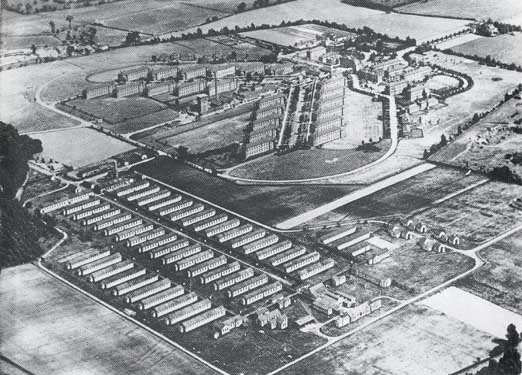The MAB (Metropolitan Asylum Board) was responsible for the treatment of Londonís infectious diseases such as scarlet fever, diphtheria and smallpox, during a smallpox epidemic the Board originally used its London based Hospital to treat patients, but this usually caused uproar with the local residents. With the increase in smallpox cases and the resistance from locals the MAB was forced to rethink its policy of using local hospitals and eventually a decision was taken to use tented smallpox camps. On the14th may 1881 on the site of the Darenth Valley Hospital Dartford tents were erected to accommodate 137 smallpox patients. The tents remained in place until the following autumn when it was necessary due to the onset of cold weather to move the patients to vacant buildings of a nearby School for Imbeciles that the MAB owned.
During May 1883 the Metropolitan Asylums Board purchased Gore Farm Darenth, Dartford and a 2nd Tented Camp was established, This was then followed by the purchase of two wooden gun ships the Atlas and the Endymion and a ferry the Castalia. The Atlas and the Castalia were converted into hospital ships giving a total of 350 beds this left the Endymion which was used for storage and Administration. The ships were moored off Long Reach north of Dartford; the MAB then purchased the adjacent land to the ships and erected a pier. The Paddle steamers Genva Cross and the Albert Victor were used to transport smallpox patients from the metropolis to the ships. On the site of the 2nd smallpox tented camp at Gore Farm the permanent hospital Gore farm hospital later to become the Southern Hospital was completed in 1890. As nobody wanted a smallpox hospital in there locality the early 1900s saw three smallpox hospitals built on the adjacent land to the hospital ships at long reach. In 1901 the construction of the temporary 300 bed Long Reach Hospital was completed only to be followed by the nearby temporary 800 bed Orchard Hospital in 1902. Finally the permanent Joyce Green Hospital was completed in 1903 following its completion there was now adequate beds and the ageing hospital Ships were scraped.
Joyce Green Hospital was designed by A & C Harston, the hospital consisted of 22 wards arranged symmetrically with 11 wards arranged as a echelon either side of the central spine of administive buildings this layout avoided a main sewer. The wards were connected by covered walkways and a horse draw tram was used to convey smallpox patients from long reach pier to the wards the tram also served the Orchard and Long Reach Hospitals in total 3.4 Miles of track was laid. The tramway track remained in place until 1943 when it was lifted for scrape metal to help with the war effort. Southfields House situated at the South Gate was the home of Joyce Greens first Medical Superintendent Dr T F Ricketts, highly respected even today for his diagnosis of smallpox. Dr Ricketts remained Medical Superintendent at Joyce Green until his retirement in 1914. 1n 1919 Harry Hopkins returned from the war to his post as head Gardiner now working for Dr A F Cameron as the Medical Superintendent who had referred to Joyce green grounds as Ďa wilderness covered by rough grass with a few treesí. It was not long before Hopkins struck a good working relationship with Dr Cameron and the following years saw Joyce Greens grasslands transformed into tree-lined streets and impressive boarders. In 1939 Joyce Green moved from isolation hospital to become a General Hospital it survived bombing raids and was used to treat war causalities after the war Joyce Green continued as a General Hospital until its closure in September 2000. Joyce Greens Hospitals cemetery even today raises concerns with the encroachment of housing and the burial of smallpox cases on the site, parents have voiced fears about children playing on the now over-grown cemetery. For gruesome details of how smallpox cases were prepared for burial please click here.
The Orchard Hospital was designed by A & C Harston and completed in 1902, linked by the Joyce Green Hospital to Long Reach tramway, the hospital was only opened for major epidemics. During the First World War the Australian military acquired the hospital and renamed it on the 9th October 1916 The Dartford Australian Auxiliary Hospital , after the 1st world war Orchard Hospital was once again only used for the occasional epidemics. During the Second World War fire bombs landed on the east buildings which resulted in the wooden structures being badly damaged. Some of the unscathed buildings were converted to agricultural use and the rest were completely demolished a few years later.
The Long Reach Hospital was constructed in 1901 to provide 300 more beds to the over crowded Hospital Ships. Patients arrived at long reach pier by ambulance steamer, a horse drawn tram was provided to complete the journey to the wards the tram was later to convey patient To the Orchard and Joyce Green Hospitals. The Metropolitan Asylums Board decided in 1910 keep Long Reach permanently in reserve by this time the wooden buildings were in need of repair but it was not until 1928 when the original structures were demolished and replaced with permanent structures accommodating 254 beds. Long Reach with staff remained as a stand-by smallpox hospital until its closure in 1974.

Medical Superintendent Dr T F Ricketts.

The Orchard Hospital.

Joyce Green Hospital.
Above Dr T F Ricketts, Orchard Hospital and the Joyce Green Hospital.
Joyce Green hospital did go out in a blaze of glory as some of the redundant building prior to demolition were used for a scene in the popular television series Londonís Burning.
Last updated 01-01-09 © History Man